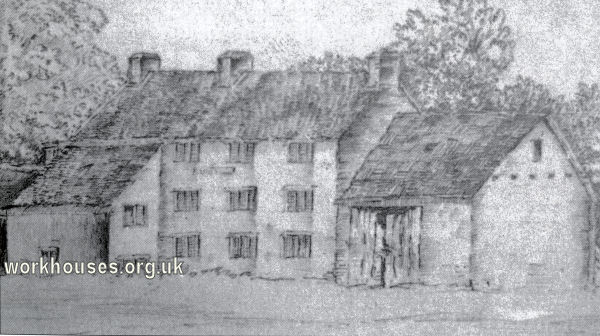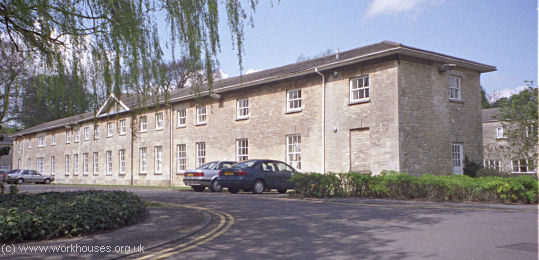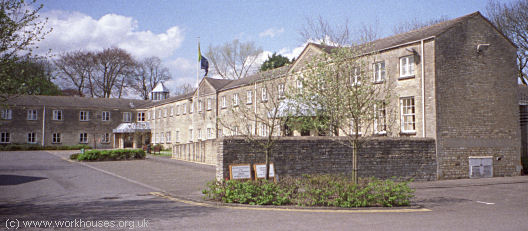Cirencester, Gloucestershire
Up to 1834
Cirencester was the subject of a report in An Account of Several Workhouses..., dated December 30th, 1724.
A subsequent report, dated 27th December, 1729, reported on the success of the new workhouse:
A parliamentary report of 1777 recorded a parish workhouse in operation at Cirencester for up to 120 inmates. In 1810, the parish adopted Gilbert's Act, which excluded the able-bodied from indoor relief.
In 1797, Fairford adopted Gilbert's Act and opened a workhouse in a converted barn at the south of the Crofts, later the site of the town's cottage hospital. Its female inmates spun flax and worsted.

Fairford workhouse.
After 1834
Cirencester Poor Law Union was formed on 21st January 1836. Its operation was overseen by an elected Board of Guardians, 43 in number, representing its 39 constituent parishes as listed below (figures in brackets indicate numbers of Guardians if more than one):
Gloucestershire:
Ampney Crucis, Ampney St Mary, Ampney St Peter, Badgington (Bagendon), Barnsley, Baunton, Brimpsfield, North Cerney, South Cerney, Cirencester (4), Coates, Colesbourne, Daglingworth, Down Ampney, Driffield, Duntisbourne (Dunsbourne) Abbots, Duntisbourne (Dunsboure) Lyre, Edgeworth, Elkstone, Fairford (2), Harnhill, Heatherop, Kempsford and Welsford, Maisey Hampton, Preston, Quennington, Rendcomb, Redmarton, Sapperton, Siddington, Stratton, Syde, Winston.
Wiltshire:
Kemble, Marston Maisey, Poole Keynes, Poulton, Shorncote, Somerford Keynes.
The population falling within the union at the 1831 census had been 18,720 with parishes ranging in size from Shorncote (population 29) to Cirencester itself (5,420). The average annual poor-rate expenditure for the period 1833-35 had been £10,777 or 11s.6d. per head.
The new Board of Guardians had their first meeting on 22nd January, 1836, and formed a committee to organise the planning and construction of a workhouse for 250 inmates. The new building was erected on the site of the old Cirencester parish workhouse, which was demolished. The Committee advertised for plans and in March accepted a tender from John Plowman of Oxford. Building commenced that summer and the workhouse was completed the following year. The Poor Law Commission authorized the expenditure of £4,309 on the new workhouse, with a slightly increased capacity of 300 inmates. The site location and layout are shown on the 1902 map below.

Cirencester workhouse site, 1902.
Plowman's design was a variation popular cruciform plan, with a long entrance block facing to the south-west.

Cirencester entrance block from the south, 2000.
© Peter Higginbotham.
To the rear, four accommodation wings for the different classes of inmate (male/female, infirm/able-bodied etc.) radiated from a central supervisory hub. The octagonal hub had windows which allowed the master and matron to observe all of the exercise yards which lay between the wings.

Cirencester rear of entrance block (left) from the south-east, 2000.
© Peter Higginbotham.

Cirencester accommodation wing from the south-east, 2000.
© Peter Higginbotham.
To the rear, a further parallel block probably contained the workhouse infirmary.

Cirencester rear block from the south-east, 2000.
© Peter Higginbotham.
One other addition to the site was the Cirencester lock-up. This 18th century building originally stood in the town in Gloucester Street but was moved to the workhouse site in 1837 and placed at the west of the main building.

Cirencester Lock-up, 2000.
© Peter Higginbotham.
In 1930, the site was taken over by Gloucestershire County Council and became a 200-bed Public Assistance Institution. It became Watermoor Hospital in 1948 then was converted to council offices in about 1980. Most of the original workhouse buildings (including the lock-up) survive.
Staff
Inmates
Records
Note: many repositories impose a closure period of up to 100 years for records identifying individuals. Before travelling a long distance, always check that the records you want to consult will be available.
- Gloucestershire Archives, Clarence Row, Alvin Street, Gloucester GL1 3DW. Holdings include Guardians' minutes (1836-1935).
- Cirencester Bingham Library, The Waterloo, Cirencester, Gloucestershire GL7 2PZ. Holdings include: Printed pauper lists (1878, 1880-1912). Copies of workhouse plan, 1837.
Bibliography
- None.
Links
- None.
Unless otherwise indicated, this page () is copyright Peter Higginbotham. Contents may not be reproduced without permission.


